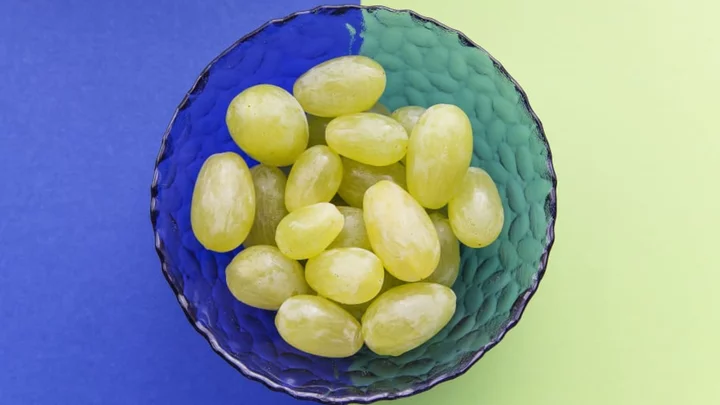The humble grape is both a TV trope synonymous with luxury in the ancient world (think: a reclining emperor demanding a servant to peel him one) and one of the world’s largest fruit crops. It’s estimated that 7.3 million hectares of Earth’s surface was planted with grape vines in 2022.
Grapes are popular fresh—they’re the third most popular fruit bought by shoppers in the United States—and people also love consuming them as wine, jam, juice, various dried varieties, jelly, vinegar, grape seed extract, and grape seed oil. It’s this versatile popularity, coupled with the many countries that harbor good growing conditions, that have crowned the grape as one of the world’s most economically important crops. Here are some fascinating facts about one of the most ubiquitous fruits.
1. Grapes are used to make synthetic leather.
In the quest to find cruelty-free and more environmentally friendly synthetic leather, Vegea, an Italian company founded in 2018, has made a fully recyclable and biodegradable product from the grape waste left over from winemaking. The grape leather’s environmental credentials surpass those of many typical synthetic alternatives made from the petrochemical industry.
The product itself also helps solve the problem of wine industry waste disposal: Globally, winemaking produces an annual 14 million tons of waste. Much of that is burned, which contributes to carbon dioxide emissions.
Grape leather is being used for a whole host of products, including vegan-friendly shoes, bags, and boxing gloves. In 2019, luxury car brand Bentley revealed an electric concept car furnished with Vegea’s wine fabric. And in 2022, British designer Stella McCartney showed off her collection of grape leather sneakers and bags at Paris Fashion Week.
2. Grapes can be deadly to your pet.
Grapes and their derivatives (raisins, currants, sultanas, wine, and grape juice) are toxic to dogs: They can cause kidney failure, which can ultimately be fatal [PDF]. Signs of poisoning have also been seen in cats, but it’s rarer (possibly because cats are less likely to be tempted by a grape). After many years of speculating about why grapes are so toxic to our furry friends, in 2021, vets at the ASPCA discovered that tartaric acid contained in the fruit is the culprit.
Symptoms of grape poisoning include vomiting, diarrhea, and excessive thirst. Because the effects of poisoning can be so severe, vets recommend taking your pet for immediate treatment—even if you only suspect they may have eaten a grape and they aren’t showing any adverse symptoms.
3. The grapes you eat are different from the ones used in winemaking.
A grape is just a grape, right? Not necessarily. The qualities desired from the ones you eat fresh (table grapes) are quite different from those required for wine production (wine grapes). While all popular wine grapes and most table grapes are variations of the species Vitis vinifera, cultivation has created grapes with certain characteristics that are better suited for particular purposes.
The seeds and thicker skins on wine grapes lend more flavor and color to the wine, while their greater sweetness aids the fermentation process. Wine grapes are also harvested later, when their sugar concentrations have increased. The most popular wine grape is the Cabernet Sauvignon, followed by Merlot.
Table grapes tend to be larger and more palatable: juicy with firmer flesh and a less concentrated flavor, with a thinner skin and fewer seeds. These varieties produce a higher yield, with more grapes on the vines. Table grapes also include species such as the North American Fox Grape (Vitis labrusca) and Muscadine (Vitis rotundifolia), which are perfect for eating but with less than desirable wine-making characteristics (according to many European and Californian wine growers, at least).
4. China leads the way in table grape production and consumption.
Thanks to its favorable climate and growing conditions, China has been growing grapes for more than 2000 years. Data from the U.S. Department of Agriculture shows that table grapes have recently become increasingly popular in China [PDF]. Consumption is expected to increase from 11.8 million metric tons in 2021–2022 to 12.4 million metric tons in 2022–2023, making China the world’s largest consumer; in 2019, it consumed more than twice the amount of the second-largest consumer, the U.S.
China doesn’t just consume a lot of grapes. The country’s expected table grape production in 2022–2023 is 12.6 million tons—more than half of the world’s grape production—making it the world’s top grape producer as well.
5. People have been eating grapes and influencing their evolution for 22,000 years.
In 2017, scientists sequenced and compared the genomes of wild and domesticated grapes. They found that the samples diverged during the last Ice Age, around 22,000 years ago—thousands of years before humans started to cultivate them. They also found that grape populations underwent a long, steady decline prior to domestication. This could have been due to some unknown natural cause, but the researchers hypothesized that humans foraging grapes in the wild were influencing their evolution long before they started domesticating them.
6. Grapes were probably the first fruit domesticated by humans.
According to archaeological evidence in the form of trace quantities of winemaking acids found on clay pottery fragments, people were growing grapes for harvest in the Middle East around 6000 BCE. But we may have domesticated the fruit long before then.
In 2023, researchers published genetic evidence that grapevines were domesticated around 11,000 years ago. By studying grape genome sequences, they found that the fruit was independently domesticated in two separate regions concurrently: the region in western Asia home to Lebanon, Jordan, Palestine, and Israel, and the region covered by modern-day Azerbaijan, Armenia, and Georgia. As the scientists remarked, “The grapevine was probably the first fruit crop domesticated by humans … It was one of the first globally traded goods.”
7. Most wines originate from a single domesticated grape species.
The Eurasian Vitis vinifera is the single domesticated species of grape responsible for the most popular wines—whether Chardonnay, Merlot, Pinot Noir, or Cabernet Sauvignon. Each grape variety has a specific name, but the species behind them is the same. Varieties of Vitis vinifera are considered best for producing world-class wines due to their high sugar content and moderate acidity.
Native North American species haven’t been used in wine-making experiments for nearly as long as Vitis vinifera, so the vinos they create tend to have a more niche appeal. Fox grape (Vitis labrusca) produces Concord wines that are often dismissed as smelling “foxy”; Muscadine (Vitis rotundifolia) produces Muscadine wines, which are typically sweet; and Bunch grape (Vitis aestivalis) produces the robust and fruity red Norton wine.
8. Grapes grow in amazing places.
Wineries are often synonymous with particular settings (think: Napa Valley, the Loire, Tuscany) but there are also some unique and dramatic environments associated with grape growing.
The remote volcanic vineyards of La Geria on the Spanish Canary Island of Lanzarote grows vines that thrive in an otherwise-barren moonscape. An eruption in the 1730s wiped out more traditional forms of agriculture there, simultaneously transforming it into a region ideal for winegrowing, thanks to the rich nutrients in the soil. Most of La Geria’s vineyards produce their own artisan wines. Growers use techniques adapted to the environment, including digging hollows in which to plant each vine and surrounding them with low, semi-circular stone walls as protection from Atlantic winds.
Thailand is also home to some extraordinary vineyards. The famous “floating” vineyards of the Samut Sakorn District are planted in the Chao Praya Delta between the rivers of Mae Klong and Tha Chin. They have long produced table grapes, and now supply wine grapes for the growing Thai wine industry. The magical illusion of buoyant vines is created by a network of drainage canals surrounding small, rectangular islet vineyards. People float on small barges or balance on bamboo sticks laid across the canals to harvest the grapes.
9. Ancestral grapes had much less variation in color.
Anthocyanins are the chemicals found in grapes that determine their pigment (usually in the skin), with a particular family of genes responsible for the variation in anthocyanin content. The many grape color variations, from yellowy-green through shades of pink and red to purple and black, are due to the concentration of anthocyanins in the grapes. It’s thought the wild ancestor of modern-day wine varieties was likely black, similar to modern-day wild grapes. Generations of growers selected grapes for their color, leading to the diversification we see today.
10. An introduced pest nearly destroyed the world’s vineyards.
Sometime in the 1850s, an aphid native to North America known as grape phylloxera made its way across the Atlantic and promptly set about destroying European viticulture. Things became so desperate that families who had been tending vineyards for generations burned them to the ground in a somewhat futile attempt to stop the spread. Everywhere the European vines grew—from Europe itself to South Africa and the U.S.—faced destruction.
France was particularly affected in an event that became known as the Great French Wine Blight. With thousands of hectares of vineyards lost and many families facing financial ruin, the French government offered a generous financial reward to anyone who could find a cure. The holy grail for curing phylloxera infestations remains elusive to this day, but people did find a way to curb its progression by grafting European vines to phylloxera-resistant American rootstock such as Vitis labrusca or Vitis riparia. This—a first foray into grape hybridization—stopped the root-eating louse in its tracks, although the French government remained unimpressed. Somewhat pedantically, they pointed out that regardless of this success, it failed the “cure” criteria, so they refused to cough up the reward.
11. Hybrid grape-growing is gaining popularity in response to climate change.
Experiments with hybridization continued in the search for grapes resistant to other issues like rot, fungi, and disease. But until recently, European standards banned wine made from hybrids due to their supposed inferior quality (eastern North America, on the other hand, has a long tradition of farming hybrid varieties). Climate change is opening the door once more to hybrid varieties, particularly in the U.S. but also tentatively in Europe. In 2021, the EU changed its regulations, permitting the right to use resistant, hybrid grape varieties in “appellation” wines.
Climate change, with its more erratic and extreme weather, has wreaked havoc on grape crops in recent years: sudden cold snaps or flooding have wiped out harvests and increasing temperatures have encouraged the spread of pests. Vitis vinifera has proven particularly susceptible to these disturbances.
Horticultural scientists are combining the flavor and attributes of European grapes with the hardiness of American varieties to achieve hybrids that are resistant to the whims of the climate and the challenges they present. These hybrids also have increased resistance to disease, and as such, require fewer pesticides.
12. Grape breeders experiment with—and produce new—grape varieties.
Early grape breeders were farmers who selected the best vines with which to establish vineyards that would produce better fruit. Nowadays, grape breeding is high science often done by horticultural scientists and geneticists with specialized degrees and research experience. The scientists use hybridization, control pollination, and select parent plants from the most suitable varieties for seed production. They expedite the traditional process for breeding grapes using DNA technology that allows them to identify markers that indicate disease resistance or fruit quality.
13. The largest grape variety is the Kyoho.
The Kyoho grape is a European-American hybrid that originated in Japan in 1937. Originally popular in Japan and China but now found worldwide, the Kyoho was produced by a grape breeder who crossed the Centennial grape with the Ishiharawase. He named the result Kyoho, which translates to “great mountain peak,” in honour of Mount Fuji. The oblong grapes are 2–4 centimeters (roughly 0.78–1.6 inches) big. Their skin ranges from dark violet to almost black in color, and their green flesh is very sweet. The seeds and thick skins are bitter and often discarded. Fortunately, the Kyoho possesses a “slip-skin,” meaning the skin slides off easily, leaving the flesh intact.
This article was originally published on www.mentalfloss.com as 13 Fascinating Facts About Grapes.









